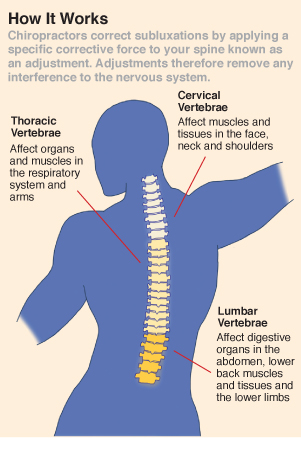The unexpected happened for senior Stephanie Stromquist when she tagged along with her mother and sister to the doctor’s office for her sister’s severe scoliosis ten years ago. Stromquist was then informed by the doctor that she too was a victim of scoliosis.
“My scoliosis wasn’t as serious as my sister’s,” Stromquist said. “Mine started as an 11 degree curve and then increased a little bit, whereas my sister’s scoliosis was almost 40 degrees, which was really bad and caused her a lot of discomfort.”
Although her sister had to undergo surgery to correct the condition, Stromquist said she goes to a chiropractor instead of taking medication and surgery. She cited reduction in pain and naturalness as reasons for choosing to go to a chiropractor.
 “(My chiropractor) makes it so that I don’t have a lot of back pain, so it feels better after he aligns me,” Stromquist said. “Chiropractic is natural; you’re just correcting and aligning your body the way it should be.”
“(My chiropractor) makes it so that I don’t have a lot of back pain, so it feels better after he aligns me,” Stromquist said. “Chiropractic is natural; you’re just correcting and aligning your body the way it should be.”
Stromquist’s case not a unique one. In a January 2012 study, Dr. Gert Bronfort, research professor at Northwestern Health Sciences University in Minnesota, and his colleagues reported that chiropractic methods and exercises proved to be more effective than medication for treating certain spinal problems, such as neck pain. The study, conducted with three different groups based on the type of treatment — chiropractic, exercise and medication — showed that after 12 weeks, the patients in the non-medication groups did significantly better than those on the medication method. In fact, about 57 percent of the patients who met with chiropractors and 48 percent who did the exercises reported at least a 75 percent reduction in pain, in contrast to 33 percent of the people who took medication.
Dr. Nancy Elwartowski-Cooper, prenatal/pediatric chiropractor at Chiropractic Wellness Center of Indiana, said via email that she agreed with this study. According to Elwartowski-Cooper, when the issue at hand involves musculoskeletal pain, chiropractic targets and fixes the root cause.
“(Chiropractors) can mobilize the joint, which reduces the swelling and muscle splinting, therefore reducing pain,” Elwartowski-Cooper said. “The medication can reduce the swelling and muscle splinting, but it doesn’t get the joint moving again. This will lead to increased frequency of pain, and re-injury just by ‘sleeping wrong’ or ‘blow drying their hair.’”
However, although chiropractic methods can alleviate pain in patients, Steve Schofield, one of CHS’ athletic trainers, said that although he is not well educated in chiropractic, he personally does not prefer chiropractic as much as exercising.
“(Chiropractors) realign you, as they say. I see that as a high velocity adjustment. I’m not a big fan of high velocity adjustment. I think that if you move more of low velocity, working with the muscle and muscle manipulation versus a ‘cracking,’ if you will, it’s better for an individual,” Schofield said.
Despite his reluctance on chiropractic solutions, Schofield said he agreed with the study in that exercise was shown to be more effective than medication for alleviating or fixing spinal pains.
“Medication’s going to take care of (only) so much. It’s going to take care of that pain, those symptoms,” Schofield said. “To get better, I believe that you need to do something to get yourself better. Exercise (can) either decrease your pain, increase your strength, increase your flexibility. Those things are going to be better for you long term in my opinion because you’re working to get those things done versus just taking a pill and taking care of your pain, or depending on medication to get rid of those pains every day.”
For Stromquist, she said she will continue to see her chiropractor instead of turning to surgery or medication because of the risks associated with pain medication.
“Chiropractic is basically more natural in my opinion,” she said. “You’re not putting things in your body that you would question, like medication. You’re just doing natural stretches and poses, and it just feels good.”































![What happened to theater etiquette? [opinion]](https://hilite.org/wp-content/uploads/2025/04/Entertainment-Perspective-Cover-1200x471.jpg)














































![Review: “The Immortal Soul Salvage Yard:” A criminally underrated poetry collection [MUSE]](https://hilite.org/wp-content/uploads/2025/03/71cju6TvqmL._AC_UF10001000_QL80_.jpg)
![Review: "Dog Man" is Unapologetically Chaotic [MUSE]](https://hilite.org/wp-content/uploads/2025/03/dogman-1200x700.jpg)
![Review: "Ne Zha 2": The WeChat family reunion I didn’t know I needed [MUSE]](https://hilite.org/wp-content/uploads/2025/03/unnamed-4.png)
![Review in Print: Maripaz Villar brings a delightfully unique style to the world of WEBTOON [MUSE]](https://hilite.org/wp-content/uploads/2023/12/maripazcover-1200x960.jpg)
![Review: “The Sword of Kaigen” is a masterpiece [MUSE]](https://hilite.org/wp-content/uploads/2023/11/Screenshot-2023-11-26-201051.png)
![Review: Gateron Oil Kings, great linear switches, okay price [MUSE]](https://hilite.org/wp-content/uploads/2023/11/Screenshot-2023-11-26-200553.png)
![Review: “A Haunting in Venice” is a significant improvement from other Agatha Christie adaptations [MUSE]](https://hilite.org/wp-content/uploads/2023/11/e7ee2938a6d422669771bce6d8088521.jpg)
![Review: A Thanksgiving story from elementary school, still just as interesting [MUSE]](https://hilite.org/wp-content/uploads/2023/11/Screenshot-2023-11-26-195514-987x1200.png)
![Review: "When I Fly Towards You", cute, uplifting youth drama [MUSE]](https://hilite.org/wp-content/uploads/2023/09/When-I-Fly-Towards-You-Chinese-drama.png)
![Postcards from Muse: Hawaii Travel Diary [MUSE]](https://hilite.org/wp-content/uploads/2023/09/My-project-1-1200x1200.jpg)
![Review: "Ladybug & Cat Noir: The Movie," departure from original show [MUSE]](https://hilite.org/wp-content/uploads/2023/09/Ladybug__Cat_Noir_-_The_Movie_poster.jpg)
![Review in Print: "Hidden Love" is the cute, uplifting drama everyone needs [MUSE]](https://hilite.org/wp-content/uploads/2023/09/hiddenlovecover-e1693597208225-1030x1200.png)
![Review in Print: "Heartstopper" is the heartwarming queer romance we all need [MUSE]](https://hilite.org/wp-content/uploads/2023/08/museheartstoppercover-1200x654.png)



